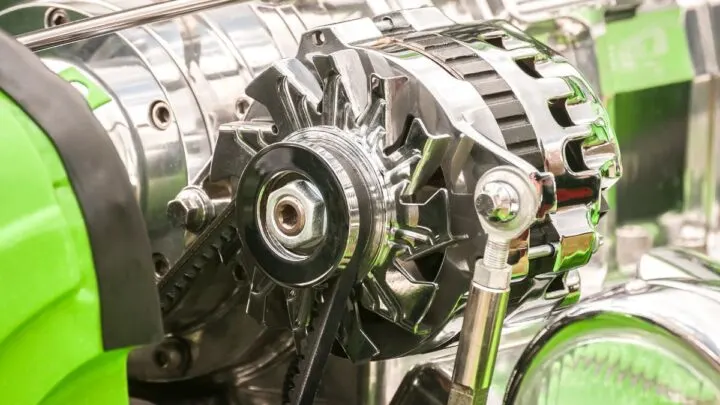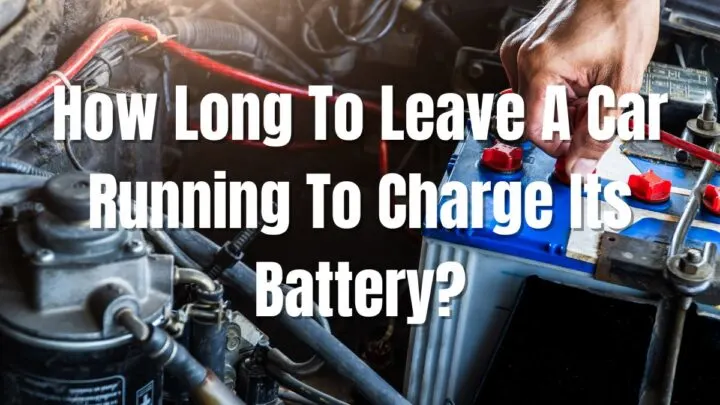The battery is an integral part of automobiles’ electrical and electronic systems.
It stores electrical energy for future use in power the ignition system and even acts as a surge protector in cases of voltage spikes.
Therefore, you can’t run a vehicle on a flat or dead battery.
But, how long can you leave your engine running to charge the battery if its charge is low?
It depends on the battery’s state in order to figure out how long to leave a car running to charge the battery. If you’ve rarely been driving, all it takes is running your engine for about 20-30 minutes to charge the battery.
However, modern cars have battery management systems (BMSs) that reduce a car’s ability to charge at lower speeds/ RPMs (idling) to extend the battery’s life.
Therefore, it’s better to drive around for some time at higher RPMs to replenish your batteries.
Furthermore, radio, AC, lights, or heaters will drain the battery and lower its charging speed.
Does Leaving a Vehicle Engine Running Charge the Battery?
You may have heard that leaving your vehicle’s engine running charges its battery. But is it true?
The short answer is yes, leaving your car engine running charges the battery.
If you don’t drive your car often, chances are that it will drain its battery faster when you’re not recharging it.
After some time, such actions will lower the battery’s charge, and you’ll wake up one morning to find it depleted or dead.
So what should you do? Here, you have two options.
One, invest in a car battery charger, and two, charge your battery by leaving the vehicle idling for some time.
Most automobiles rely on electricity to crank up the engine, and power radio devices, chargers, air conditioning units, lights, driver-assist technologies, etc.
And the automobile electrical system consists of the power sources, the distribution cables/ lines, and the loads.
The power sources consist of the battery, which stores power in chemical energy form, and the alternator.
The distribution lines are the cables and wires that distribute current to various loads within your car.
Also, an electrical load is part of a circuit or an electrical component that consumes electric power.
Now that we know that leaving a car idling charges its batteries let’s delve deeper into each of the above components’ impact.
How an Alternator Works in a Car
A common misconception amongst motorists is that the battery does all the electrical powering work in our cars.
In reality, you would need a lot of batteries to power your vehicle without the alternator. And whereas it is the battery’s duty to start your car, it is the alternator that keeps it running.
Let’s see how an alternator works.
An alternator is an electric generator that charges the battery and powers the electrical system when the engine is running.
Why should the engine be running? As we know, generators convert mechanical energy to electrical energy, which is then used to power your car’s radio, windshield wipers, and power windows.
Other components include the power rearview mirrors, the infotainment system, headlights, power steering, etc.
Vehicle alternators rely on the engine’s rotation and run at 2 to 3 times the crankshaft speed.
Turning on your vehicle’s engine rotates and powers a drive belt connected to the alternator.
Consequently, it transfers the rotational mechanical forces to the alternator’s rotor shaft.
The rotor is an electromagnetic rotational section of any synchronous generator (such as the alternator) that uses induction principles to induce a current onto the stator windings.
Conversely, inside the alternator is a series of magnets wound around a coil and attached to a rotational part (the rotor).
When you turn on your engine, the rotating alternator magnets move relative to the stationary stator windings.
The result is that they’ll automatically generate and induce alternating current (AC) onto the stator assembly.
This AC is then converted to direct current (DC) for storage in the battery or immediate use.
So, the alternator charges your car battery as long as the engine runs.

How Long Can a Car Battery Last When the Engine Is OFF?
You may be living inside your car or at an event and may want to know how long your car battery will last when the engine is OFF.
As already seen, the alternator provides the necessary electric juice to replenish your battery and power other components. However, it relies on the engine to keep running, and you’ll rely solely on the battery when it’s OFF.
So, how long will the battery last in this state?
The answer is that it will depend on the electric load draining the battery, the battery’s capacity, and its state at that time.
A newer battery will tend to outlast an older one. Similarly, the number of connected components and their power consumption will impact your battery charge life.
If you disconnect your AC and all power-draining components, you should expect your battery to hold charge for 6 to 8 weeks or less in cold weather.
Therefore, if your car has been sitting for that long, leave the engine running (idling) for 5 to 10 minutes before driving off.
You’ll be allowing the alternator to replenish the battery with enough power for a start.
Here’s What To Do When the Battery Is Dead
As seen from the sections above, a car relies on the battery to crank up but on the alternator to keep most components running.
What if the battery is dead?
The simple answer is that you won’t be able to crank up the engine and, consequently, the alternator.
Your only option would be jump-starting/push-starting the vehicle. Additionally, how you respond varies depending on the vehicle’s transmission.

How to Push-Start Manual Transmission Gasoline Vehicles
You can still start a manual transmission vehicle using the momentum of its rolling wheels.
In this way, you’re manually cranking the engine by working your way backwards. That is rolling the wheels to run the engine’s shaft and hence starting it without necessarily relying on the starter.
However, this method is tougher on the high-compression diesel and automatic engines.
It’s more successful in vehicles with gasoline engines, carburettors, and inductive discharge ignition or capacitor discharge ignition (CDI) systems.
If possible, here’s a common way to push start a manual transmission gasoline engine vehicle.
- Set up the vehicle down a slope to make maximum use of gravitational forces. Obviously, it’s harder pushing a vehicle uphill.
- Next, turn on the ignition and put the transmission in the second gear.
- Next, depress the clutch.
- Ask for aid pushing the vehicle until it achieves speeds of 5 to 10 mph or more.
- Quickly disengage the clutch while partially depressing the gas pedal, and your engine will start running.
- At this stage, there’s no need to push the car as it can run on its own.
How to Jump-Start Automatic/ Manual Transmission Vehicles
You cannot push-start automatic/ semi-automatic transmission vehicles since the selection of transmission gears is only possible when the gearbox internals are rotating.
Here, your best option would be jump-starting the vehicle.
Jump-starting is simply using an external electrical source to revive a flat battery enough to crank up the engine.
Once the engine is on, the alternator takes over and provides sufficient charge for the battery.
However, if you have a flat battery, it’s imperative that you leave your car’s engine idling for close to 30 minutes for the battery to hold up sufficient power.
Here’s how to jump-start your car using jump leads.
- Position your car close to another vehicle so that the jump leads can reach both batteries effortlessly. Ensure that the jump leads are fully insulated to avoid short circuits that might “fry” both batteries.
- Switch off the running car’s engine, and attach the positive-designated crocodile clip to its battery’s positive (+) terminal. Next, attach the opposite end to the flat battery’s positive terminal.
- Next, connect the negative-designated crocodile clip to the charged battery’s negative (-) terminal.
However, here, you’ll attach the opposite end of the negative jump lead to an earthing point on your vehicle.
A good earthing point is a metal section on your car’s chassis or engine block away from the battery and fuel systems. - Relax for a few minutes and crank up the working car’s engine. Let it run for one or two minutes.
- Afterward, start your car and let both vehicles run for close to 10 minutes.
- After the time elapses, disconnect both jump leads in reverse order. That is, start with the earthed negative terminal on your car and finally the positive terminal on the working vehicle. FYI, the order is important here.
- Restart your car and leave it running for close to 30 minutes.
The Takeaway on How Long To Leave a Car Running to Charge the Battery
Car batteries last three to five years depending on their type, your driving, weather conditions, etc.
Additionally, leaving your car sitting in the garage for 1-2 months will kill its battery.
However, this depends on the battery’s age, quality, original charge, power-draining features in the car, and ambient temperature.
To prevent it from dying, use a smart trickle or standard charger to top up the battery every two weeks.
If you found this article helpful, make sure to take a look at some of the other battery-related posts linked below!
